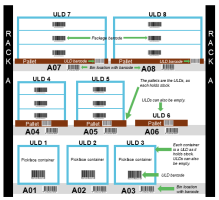Terms
The following list is a dictionary of terminology used in .wms.
|
Term |
Definition |
|---|---|
|
3PL |
Third Party Logistics Outsourcing of ecommerce logistics to a third party business, including stock/inventory management, warehousing and fulfillment, 3PL provides enable ecommerce merchants to accomplish more, with the tools and infrastructure to automate order fulfillment. |
|
3PL provider |
A 3PL company that provides logistics services which includes anything that involves management of one or more areas of storing and/or shipping items (stock). |
|
ASN |
Advanced Shipping Notice A document that provides detailed information about a pending delivery. An ASN notifies a customer when shipping occurs and provides physical characteristics about the shipment so that the customer knows what to expect. |
|
ATP |
Available to Promise Allows a business to keep the minimum amount of a given product within their warehouse so that they use their inventory space efficiently. Data is used to match supply as close to demand as possible to avoid overstocking and backorder issues. This maximises both profit and customer satisfaction and aides in predicting inventory. Available to Promise = total stock - stock on order where total stock = ULD stock + picked stock |
|
BOM |
Bill of Material |
|
Cost centre |
A cost centre is a department or functional area within an organisation that incurs expenses but does not generate direct revenue. It is a specific unit or section responsible for particular tasks or services. The costs associated with this cost centre are analysed to evaluate performance and efficiency. |
|
Countback |
Countback functionality allows operators to complete a quick cycle count of an item while it is being picked. This allows a site to constantly have stock on hand values updated without conducting a full stocktake. |
|
Disposition code |
Disposition codes are a collection of rules that can be used when items are received. For example, when an operator uses a RF scanner to receive items that were damaged, the operator must then scan a disposition code for the damaged items. The inventory status of the goods received and the location can be determined from the scanned disposition code. |
|
Ecommerce logistics |
The process of storing and shipping stock (inventory) for an online store or marketplace. The process begins with moving inventory from the manufacturer and ends when the inventory arrives at the customer's destination. It includes stock/inventory management, picking, packing and shipping of online orders. |
|
EDI |
Electronic Data Interchange The automated exchange of business documents between organisations using digital systems. EDI allows you to communicate with customers using common platforms such as XML. |
|
ERP |
Enterprise Resource Planning A business management software system designed to manage and streamline an organisation's functions, processes and workflows with automation and integration. |
|
GTIN |
Global Trade Item Number |
|
GVW |
Gross Vehicle Weight |
|
PDA |
Personal Digital Assistant A PDA is used in any process that affects traceability, control and tracking of items, from the warehouse to its sale, including returns. |
|
Pickface |
A stock location which is easily accessed by pickers at ground level without the use of any machinery or aides. |
|
POD |
Point of Delivery or Proof of Delivery |
|
RF scanner |
Radio frequency scanner Wireless handheld devices used to automate data entry of physical items so that they can be logged, tracked and managed. RF scanners wirelessly communicate with .wms to transfer scanned information in real-time. |
|
RFID |
Radio Frequency Identification |
|
SKU |
Stock Keeping Unit |
|
SLA |
Service Level Agreement A goal or agreed on timeframe for businesses to define standards of performance to respond to and/or resolve client messages. Thereby meeting service goals and customer expectations. |
|
SSCC |
Serial Shipping Container Code |
|
Tenant |
The business owner who is responsible for monitoring and managing stock/inventory to ensure its currency and accuracy in the procurement and fulfillment process managed by the 3PL provider. In the 3PL database, the tenant is sourced from the 3PL customer database. |
|
Trade units |
The number of units associated with a barcode for a different packaging size of an item. Available trade unit types:
Each item can only have one trade unit for each trade unit type. The exception is additional which can be used multiple times for each item. Trade units are not intended to be used to manage size, colour or style. Items which have different sizes, colour or styles should have individual item data records created. To explain the different trade unit types, let us use the example of a pen:
|
|
UID |
Unique Identifier |
|
ULD |
|
|
UOM |
Unit of Measure |
|
Warehouse capacity utilisation |
The total amount of space that is used as a percentage of the total amount of available space. |
|
ZPL |
Zebra Programming Language Programming language used by all ZPL compatible printers. |
